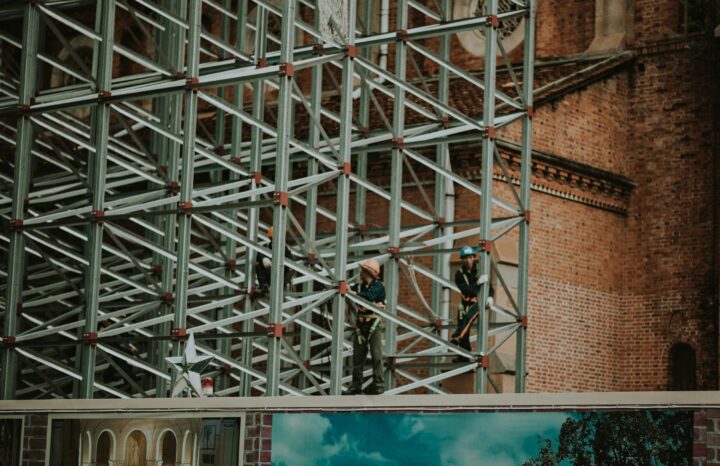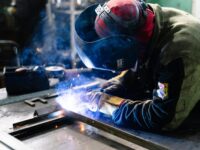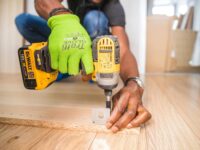The following contribution is from another author.
Have you ever walked past a construction site and noticed all those metal frames wrapped around buildings? Those structures aren’t just random metal poles – they’re called scaffolding, and they’re way more important than most people realize. Every construction project needs the right type of scaffolding to keep workers safe and get the job done properly.
What Makes Scaffolding So Important
Think about it – construction workers need to reach every part of a building, from the ground floor all the way to the roof. They can’t just use ladders for everything because they need somewhere stable to stand while they work with heavy tools and materials. Scaffolding gives them a solid platform that can hold multiple people and equipment at the same time.
Safety is the biggest reason why scaffolding matters so much. When someone is working 20 or 30 feet off the ground, one wrong step could be deadly. Good scaffolding has guardrails and safety features that prevent workers from falling. It also spreads out the weight evenly, so the structure won’t collapse under pressure.
The Main Types of Scaffolding Systems
Construction companies use several different types of scaffolding, and each one works best for specific situations. The most common type is called tube and coupler scaffolding. This system uses metal tubes connected with special clamps called couplers. Workers can adjust the height and shape easily, which makes it perfect for buildings with unusual shapes or when plans change during construction.
Frame scaffolding is another popular choice, especially for straightforward projects. It uses pre-made frames that stack on top of each other, creating a strong and stable structure. This type goes up quickly and works great for buildings with flat walls and regular shapes.
For really tall buildings or complex projects, many construction teams turn to system scaffolding. Companies that specialize in access equipment, such as toptower.co.uk, often provide these advanced systems because they require special knowledge to set up safely. System scaffolding uses standardized parts that fit together perfectly, creating incredibly strong structures that can reach impressive heights.
When Different Projects Need Different Solutions
Not every construction job is the same, so the scaffolding needs change too. When workers are building a simple house, they might only need basic frame scaffolding around the outside walls. But when they’re working on a skyscraper or a bridge, they need something much more complex and sturdy.
Renovation projects often require the most creative scaffolding solutions. Old buildings have weird angles, decorative features, and tight spaces that make standard scaffolding impossible to use. In these cases, construction teams might use cantilever scaffolding, which extends out from the building without touching the ground below. This type works perfectly when there’s no room to put scaffolding legs on the ground.
Some projects need scaffolding that can move around. Mobile scaffolding has wheels on the bottom, so workers can push it to different spots without taking the whole thing apart. This saves tons of time when painting large buildings or doing maintenance work that covers a lot of area.
Special Scaffolding for Unique Challenges
Construction sites face all kinds of unusual problems that require special scaffolding solutions. When workers need to repair a bridge, they can’t block traffic underneath, so they use suspended scaffolding that hangs from the bridge itself. This type of scaffolding takes a lot of planning and engineering to make sure it’s safe.
Weather creates another challenge for scaffolding systems. In areas with strong winds, construction teams need extra bracing and tie-ins to keep the scaffolding stable. Some scaffolding even comes with protective screens that shield workers from wind and debris while they work.
Indoor projects have their own scaffolding requirements too. When renovating the inside of a building, workers often use lightweight aluminum scaffolding that won’t damage floors or create too much noise. This type is easier to move around tight spaces and won’t leave marks on walls or ceilings.
Safety Rules That Determine Scaffolding Choices
Different types of work have different safety requirements, and this affects what kind of scaffolding construction teams can use. When workers are doing electrical work, they need scaffolding made from materials that don’t conduct electricity. Fiberglass scaffolding works perfectly for these jobs because it won’t cause electrical accidents.
Chemical plants and refineries have strict rules about what materials can be used near dangerous substances. Regular steel scaffolding might create sparks that could cause explosions, so these sites use special non-sparking materials instead.
The height of the work also determines safety requirements. Projects under 20 feet might only need basic scaffolding, but anything higher requires extra safety features. This includes better guardrails, toe boards to prevent tools from falling, and special platforms that can handle more weight.
How Weather and Location Affect Scaffolding Decisions
The environment around a construction site plays a huge role in choosing the right scaffolding. Coastal areas with salt air need scaffolding that won’t rust quickly, so construction teams often use aluminum or specially coated steel. Mountain projects deal with snow loads and freezing temperatures, which require stronger scaffolding that won’t become brittle in cold weather.
Urban construction sites have limited space, so the scaffolding needs to fit in tight areas without blocking sidewalks or streets. Rural projects might have more room to work with, but they could face challenges getting heavy scaffolding equipment to remote locations.
Making the Right Choice Every Time
Choosing the wrong type of scaffolding can slow down a project, waste money, or even put people in danger. That’s why construction managers spend so much time planning exactly what type of scaffolding each project needs. They look at the building design, the type of work being done, the timeline, and the budget before making their decision.
The best construction teams understand that scaffolding isn’t just a tool – it’s a critical part of every successful project. When they pick the right type of scaffolding for each job, workers stay safe, the project moves smoothly, and everyone goes home at the end of the day. That’s why construction sites need so many different types of scaffolding systems, and why choosing the right one makes all the difference in the world.

















Looking for a personal loan for merchant navy professionals? Sail smoothly with custom loan options designed for your unique income and travel profile. Enjoy quick approvals, flexible EMIs, and minimal documentation. Visit personal loan emi calculator to check your eligibility and get expert support today.
Great post! It’s easy to underestimate how important the type of scaffolding is on a construction site. I liked how you broke down the different options and their specific use cases — very practical. Safety and efficiency often come down to choosing the right setup from the start.